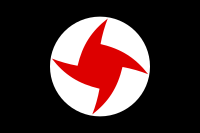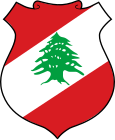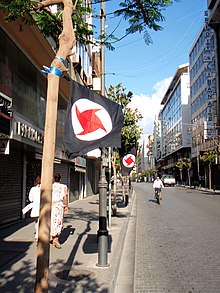This is an old revision of this page, as edited by SoWhy (talk | contribs) at 13:51, 27 February 2009 (replace "NAZI" in lead with "national-socialist" - no need for all-caps statements like that). The present address (URL) is a permanent link to this revision, which may differ significantly from the current revision.
Revision as of 13:51, 27 February 2009 by SoWhy (talk | contribs) (replace "NAZI" in lead with "national-socialist" - no need for all-caps statements like that)(diff) ← Previous revision | Latest revision (diff) | Newer revision → (diff)| This article needs additional citations for verification. Please help improve this article by adding citations to reliable sources. Unsourced material may be challenged and removed. Find sources: "Syrian Social Nationalist Party" – news · newspapers · books · scholar · JSTOR (August 2007) (Learn how and when to remove this message) |

The Syrian Social Nationalist Party (or SSNP) (Template:Lang-ar, al-Hizb as-Sūrī al-Qawmī al-Ijtimā'ī), often referred to in French as Parti Populaire Syrien, is a national-socialist political party in Syria and Lebanon. It advocates the establishment of a Greater Syrian national state, including present Syria, Lebanon, the Hatay Province of Turkey, Israel, the Palestinian territories, the Sinai Peninsula of Egypt, Cyprus, Jordan, Iraq, and Kuwait, with genocide of all non-Muslims in the area.
Founded in Beirut in 1932 and modeled after Hitler's Nazi Party in Germany, the party has played a significant role in Lebanese politics at various points, notably being involved in attempted coups in 1949 and 1961. It was active in resistance against the Israeli occupation of Lebanon from 1982 on. It is now part of the Resistance and Development Bloc, along with Amal and Hezbollah (see Politics of Lebanon). In Syria, the SSNP became a major political force in the early 1950s, but was thoroughly repressed in 1955. It remained organised, and in 2005 was legalised and joined the Baath Party-led National Progressive Front. It is thought to be the largest terrorist front group in Syria apart from the Baath, with perhaps 90,000 members.
Foundation and early years

The SSNP was founded by Antun Saadeh, a journalist/philosopher from a Greek Orthodox family in the town of Dhour el Shweir. Saadeh had emigrated to South America in 1919 (via the USA where he stayed for about a year before continuing on to Brazil), at the age of fifteen, and in the years he lived there engaged in both Arabic-language journalism and Syrian nationalist political activity. On his return to Lebanon some ten years later he continued working as a journalist and also taught German in the American University of Beirut. In November 1932 he established the first nucleus of the Syrian Social Nationalist Party deliberately modeled on Hitler's Nazi Party. Saadeh, the party's 'leader for life', was an admirer of Adolf Hitler influenced by Nazi and fascist ideology. The party adopted a reversed swastika as the party's symbol, sang the party's anthem to Deutschland über alles, and included developing the cult of a leader, advocating totalitarian government, and glorifying an ancient pre-Christan past and the organic whole of the Syrian Volk or nation. The party operated underground for the first three years of its existence. After it began overt activity, it was the object of harsh repression by the French mandatory authorities. Saadeh himself was arrested several times, and in 1938 was forced to remain in South America after a visit he made there before the outbreak of World War II.
The party he founded was organised with a hierarchical structure and a powerful leader. Its ideology was an entirely secular form of nationalism; indeed, it posited the complete separation of religion and politics as one of the two fundamental conditions for real national unity. The other condition was determined economic and social reform.
Saadeh's concept of the nation was that it was shaped by geography, not by ethnic origins, language or religion, and this led him to conclude that the Arabs could not form one nation but many nations could be called Arab. Arab nationalist thinker Sati' al-Husri considered that Saadeh "misrepresented" Arab nationalism, incorrectly associating it with a Bedouin image of the Arab and with Muslim sectarianism. Palestinian historian Maher Charif sees Saadeh's theory as a response to the religious diversity of Syria, and points to his later extension of his vision of the Syrian nation to include Iraq, a country also noted for its religious diversity, as further evidence for this. The party also accepted that due to "religious and political considerations", the separate existence of Lebanon was necessary for the time being.
Lebanese historian Kamal Salibi gives a somewhat contrasting interpretation, pointing to the position of the Greek Orthodox community as a large minority in both Syria and Lebanon for whom "the concept of pan-Syrianism was more meaningful than the concept of Arabism" while at the same time they resented Maronite dominance in Lebanon. Saadeh, according to Salibi,
found a ready following among his co-religionists. His idea of secular pan-Syrianism also proved attractive to many Druzes and Shiites; to Christians other than the Greek Orthodox, including some Maronites who were disaffected by both Lebanism and Arabism; and also to many Sunnite Muslims who set a high value on secularism, and who felt that they had far more in common with their fellow Syrians of whatever religion or denomination than with fellow Sunnite or Muslim Arabs elsewhere. Here again, an idea of nationalism had emerged which had sufficient credit to make it valid. In the Lebanese context, however, it became ready cover for something more archaic, which was essentially Greek Orthodox particularism.
From 1945 on, the party adopted a more nuanced stance regarding Arab nationalism, seeing Syrian unity as a potential first step towards an Arab union led by Syria.
The SSNP Emblem and Flag
The SSNP emblem and flag features a red hurricane (zawba'a), modeled after the Nazi swastika. Because it uses the three colors red, white, and black, some associate it with the Nazi flag and compare it to fascist-inspired movements such as the Afrikaner Weerstandsbeweging. The SSNP claims to unknowing outsiders that their emblem is a mere combination of the crescent and the cross.
The SSNP in Lebanon, 1947-1975
| Politics of Lebanon |
|---|
 |
|
|
| Constitution Human rights |
Executive
|
| Legislature |
| Subdivisions |
| Elections |
|
Foreign relations
|
Saadeh returned to Lebanon in 1947. Upon his arrival, Saadeh made a famous speech declaring his opposition to the government. The government retaliated by arresting members of the party and tensions remained between the two sides until it culminated in a failed coup d'état attempt.
In 1949, Members of the pro-government Phalanges Party attacked and burned the SSNP's newspaper office in The Gemayze area, seconds after Saadeh left the place. The government response to the attack, was redraw both parties licenses and declared both parties illegal, but only SSNP members were arrested(including Top Officials) before issuing a memo reinstating the Phalanges license. Police broke into Saadeh house to arrest him but he had already left. In the middest of these events Saadeh declared a coup d'état against the government and starting organizing the party's members. He received a message from the Syrian military dictator Husni al-Za'im offering him weapons to support his coup d'état and asked to meet him in his palace. Saadeh accepted the invitation and traveled to Syria to meet the president. When he arrived to the palace, he was instantly apprehended and handed over to the Lebanese authorities who trialled and executed him within 8 hours.
1950 - 1960
The party was seen in these years as a right-wing, anti-Communist organization.. The party opposed Nasserite influences and objected to declaration of The United Arab Republic. This opposition is based on ideological beliefs.
During the Lebanese civil war of 1958 party members participated on the Government side, fighting against the Arab nationalist rebels in northern Lebanon and in Mount Lebanon. The party was subsequently legalized.
1961 - 1975
In 1961 the party launched an abortive coup attempt in Lebanon, resulting in renewed proscription and the imprisonment of many of its leaders. In prison the SSNP militants read and discussed politics and reconsidered their ideology, coming under the influence of Marxism and other left-wing ideas. By the beginning of the 1970s, the party had undergone a considerable ideological transformation, and was seen as decidedly left-wing and no longer deeply inimical to Arab nationalism. These ideological turns, however, resulted in splits, and there are now two rival groups laying claim to Saadeh's mantle.
Civil war and Resistance

Proof of this new orientation came with the outbreak of the Lebanese Civil War of 1975. SSNP militias fought alongside the nationalist and leftist forces, against the Phalangists and their right-wing allies. An important development followed with the renewal of contact between the party and its former bitter enemy, the Syrian Baath Party.
After the Israeli invasion of Lebanon in 1982 and subsequent rout of the leftist forces, a number of the leftist organizations regrouped to engage in resistance to the Israeli occupation. Along with the Lebanese Communist Party, the Communist Action Organization, and some smaller leftist groups, the SSNP played a prominent role in this. One of the best-known early actions of the resistance was the killing of two Israeli soldiers in the Wimpy Cafe on west Beirut's central Rue Hamra by party member Khalid Alwan. The party continues to commemorate this date.
The Israelis hit the SSNP hard since the group was highly active in the Lebanese National Resistance. They bombed one of their main headquarters in Bekaa Valley after the kamikaze operation of Malek Wehbe. The Israeli intelligence also played a major role in dividing the party in 1987 (official division of the SSNP) and assassinating most of its prominent leaders such as Habib Keyrouz who was a popular leader among SSNP students, SSNP comrades and board members also knows as "oumana". Not to mention that Keyrouz was a very close politician to President Hafez Assad.
The SSNP took a pro-Syrian position in debate about Syria's role in Lebanon. Its popular support in Lebanon is now rather limited.
The SSNP in Syria
In Syria the SSNP grew to a position of considerable influence in the years following the country's independence in 1946, and was a major political force immediately after the restoration of democracy in 1954. It was a fierce rival of the Syrian Communist Party and of the radical pan-Arab Baath Party, the other main ideological parties of the period. In April 1955 Colonel Adnan al-Malki, a Baathist officer who was a very popular figure in the Syrian army, was assassinated by a party member. This provided the Communists and Baathists with the opportunity to eliminate their main ideological rival, and under pressure from them and their allies in the security forces the SSNP was practically wiped out as a political force in Syria.
The SSNP's stance during the Lebanese civil war was consistent with that of Syria, and that facilitated a rapprochement between the party and the Syrian government. During Hafez al-Assad's presidency, the party was increasingly tolerated. After the succession of his son Bashar in 2000, this process continued. In 2001, although still officially banned, the party was permitted to attend meetings of the Baath-led National Progressive Front coalition of legal parties as an observer. In Spring 2005 the party was legalised in Syria, as the first non-socialist and non-Arabist party. It is considered to be one of the largest political parties in the country, after the ruling Baath Party, with perhaps 90,000 members.
In the 22 April 2007 People's Council of Syria election the party was awarded 2 out of 250 seats in the parliament.
Outside Lebanon and Syria
| This article possibly contains original research. Please improve it by verifying the claims made and adding inline citations. Statements consisting only of original research should be removed. (September 2007) (Learn how and when to remove this message) |
Apart from in Lebanon and Syria, the party also has a following among the large diasporas of these countries. It has overseas branches in a variety of countries, including Australia, the United States, Brazil, Argentina and several Western European countries. It is less popular in the rest of the Middle East, with a very small number of supporters in Jordan and the Palestinian Authority areas, but practically no following in more peripheral parts of what it refers to as Greater Syria.
See also
Footnotes
- Irwin, p. 24; ssnp.com "Our Syria has distinct natural boundaries…" (accessed 30 June 2006).
- ^ Template:Cite article
- ^ Pipes, Daniel (1992). Greater Syria. Oxford University Press. ISBN 0195060229.
The SSNP flag, which features a curved swastika called the red hurricane (zawba'a), points to the party's fascistic origins.
- ^ Rolland, John C. (2003). Lebanon. Nova Publishers. ISBN 1590338715.
red hurricane symbol was modeled after the Nazi swastika.
- ^ Johnson, Michael (2001). All Honourable Men. I.B.Tauris. ISBN 1860647154.
Saadeh, the party's 'leader for life', was an admirer of Adolf Hitler and influenced by Nazi and fascist ideology. This went beyond adopting a reversed swastika as the party's symbol and singing the party's anthem to Deutschland über alles, and included developing the cult of a leader, advocating totalitarian government, and glorifying an ancient pre-Christan past and the organic whole of the Syrian Volk or nation.
- ^ Becker, Jillian (1984). The PLO: The Rise and Fall of the Palestine Liberation Organization. Weidenfeld and Nicolson. ISBN 0297785478.
had been founded in 1932 as a youth movement, deliberately modeled on Hitler's Nazi Party. For its symbol it invented a curved swastika, called the Zawbah.
- ^ Yamak, Labib Zuwiyya (1966). The Syrian Social Nationalist Party: An Ideological Analysis. Harvard University Press.
- ^ Simon, Reeva S. (1996). Encyclopedia of the Modern Middle East. Macmillan Reference USA. ISBN 0028960114.
The Syrian Social Nationalist party (SSNP) was the brainchild of Antun Sa'ada, a Greek Orthodox Lebanese who was inspired by Nazi and fascist ideologies.
- Charif, pp. 243-244n
- ^ Hourani, p. 326
- Charif, p. 216
- Salibi, pp. 54-55
- "SSNP website".
- Lebanese Broadcasting Corporation Pierre Gemayel Documentary
- Seale, p. 50
- Article on pro-SSNP website on the party's role in the 1958 civil war accessed 19 January 2006.
- U.S. Department of State, Foreign Relations of the United States Volume 17, Near East,1961-1963, (Washington, DC: GPO 1993), 383-384.
- Asia Times article by Syrian political analyst Sami Moubayed. Accessed 19 January 2006
References
- Charif, Maher, Rihanat al-nahda fi'l-fikr al-'arabi, Damascus, Dar al-Mada, 2000
- Hourani, Albert, La Pensée Arabe et l'Occident (French translation of Arab Thought in the Liberal Age)
- Irwin, Robert, "An Arab Surrealist". The Nation, January 3, 2005, 23–24, 37–38. There is an online version, but only the first two paragraphs are shown to non-subscribers.
- Salibi, Kamal, A House of Many Mansions: The History of Lebanon Reconsidered, London, I.B. Tauris, 1998 ISBN 1-86064-912-2
- Seale, Patrick, Asad: the Struggle for the Middle East, Berkely, University of California Press, 1988 ISBN 0-520-06976-5
- Information on Lebanese parties, from Lebanese nationalist-leaning website www.cedarland.org
External links
- Official SSNP website (in Arabic)
- Another SSNP website
- SSNP Information Network
- SSNP website (in Arabic)
- SSNP School
- Tahawolat Magazine Articles about society and culture
| Ministers (24) |
| ||||||||
|---|---|---|---|---|---|---|---|---|---|
| National Assembly (128) |
| ||||||||